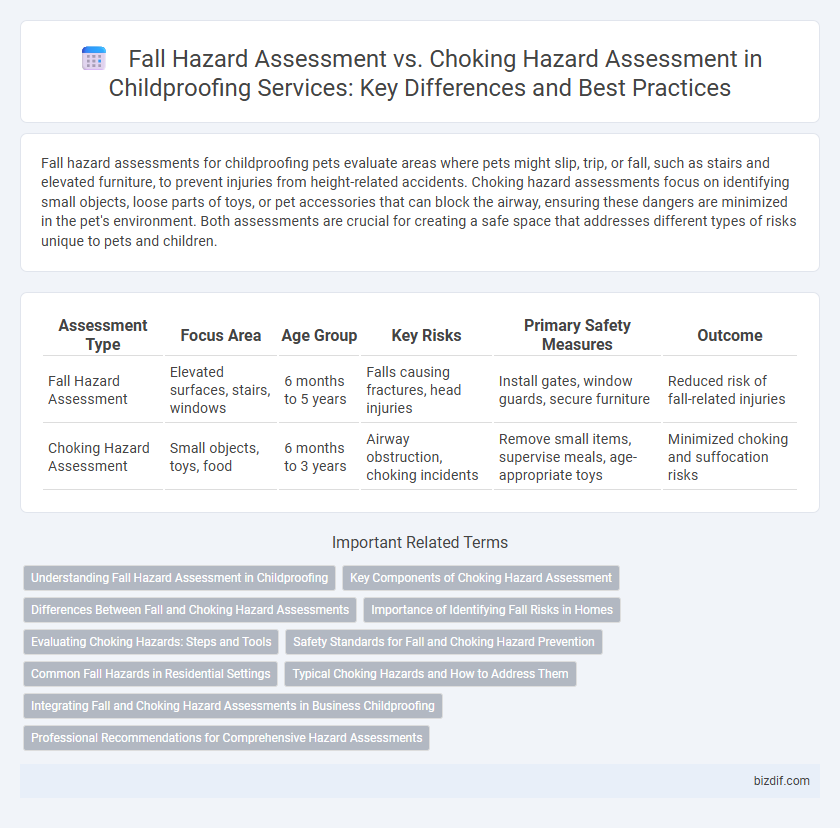Fall hazard assessments for childproofing pets evaluate areas where pets might slip, trip, or fall, such as stairs and elevated furniture, to prevent injuries from height-related accidents. Choking hazard assessments focus on identifying small objects, loose parts of toys, or pet accessories that can block the airway, ensuring these dangers are minimized in the pet's environment. Both assessments are crucial for creating a safe space that addresses different types of risks unique to pets and children.
Table of Comparison
| Assessment Type | Focus Area | Age Group | Key Risks | Primary Safety Measures | Outcome |
|---|---|---|---|---|---|
| Fall Hazard Assessment | Elevated surfaces, stairs, windows | 6 months to 5 years | Falls causing fractures, head injuries | Install gates, window guards, secure furniture | Reduced risk of fall-related injuries |
| Choking Hazard Assessment | Small objects, toys, food | 6 months to 3 years | Airway obstruction, choking incidents | Remove small items, supervise meals, age-appropriate toys | Minimized choking and suffocation risks |
Understanding Fall Hazard Assessment in Childproofing
Fall Hazard Assessment in childproofing involves identifying and mitigating risks related to heights and unstable surfaces that could cause injury to children. This process includes evaluating staircases, windows, furniture edges, and elevated platforms to implement safety measures such as gates, window guards, and corner protectors. Prioritizing fall hazard prevention helps reduce the likelihood of serious injuries in toddlers and young children during everyday activities.
Key Components of Choking Hazard Assessment
Choking Hazard Assessment focuses on identifying small objects, toys, and food items that pose a risk of airway obstruction for children under three years old. Key components include evaluating item size, shape, and texture to ensure they do not fit entirely into a child's mouth or throat. Regular inspection of play areas and adherence to safety standards such as ASTM F963 help minimize choking risks effectively.
Differences Between Fall and Choking Hazard Assessments
Fall hazard assessments evaluate risks related to a child's physical environment, focusing on potential dangers such as unsecured furniture, uneven surfaces, and open stairways that could cause injuries from falls. Choking hazard assessments concentrate on identifying small objects, toys, and food items that pose risks of airway obstruction for young children. The key difference lies in the nature of dangers assessed: fall hazards target environmental and structural risks, while choking hazards focus on ingestion and obstruction threats.
Importance of Identifying Fall Risks in Homes
Identifying fall risks in homes is crucial to preventing serious injuries in children, as falls account for a significant percentage of pediatric emergency visits. A Fall Hazard Assessment targets common dangers such as unsecured furniture, slippery floors, and stairways without gates, which often lead to traumatic injuries. Prioritizing fall risk identification ensures safer environments by addressing these potential hazards before they result in accidents.
Evaluating Choking Hazards: Steps and Tools
Evaluating choking hazards involves inspecting small objects, toys, and food items within a child's environment to ensure they do not pose a risk of airway obstruction. Tools such as the small parts tester, which simulates a child's throat size, and checklists based on age-specific safety standards are essential for identifying potential choking hazards. This systematic assessment prioritizes removal or modification of items that fail safety criteria to prevent choking incidents in children.
Safety Standards for Fall and Choking Hazard Prevention
Fall Hazard Assessment involves identifying and mitigating risks such as unsecured furniture, stairway barriers, and slippery surfaces to comply with safety standards outlined by organizations like the U.S. Consumer Product Safety Commission (CPSC). Choking Hazard Assessment focuses on detecting small objects, toys with detachable parts, and food items that meet guidelines set by the American Academy of Pediatrics (AAP) and ASTM F963 standards for toy safety. Both assessments adhere to rigorous safety regulations designed to prevent injuries, ensuring environments meet established criteria for childproofing and hazard prevention.
Common Fall Hazards in Residential Settings
Common fall hazards in residential settings include unsecured rugs, cluttered walkways, and unsecured stair gates, which pose significant risks for young children. Childproofing services conduct thorough fall hazard assessments to identify these dangers and recommend installing non-slip mats, safety gates, and proper lighting to prevent accidents. Addressing these issues reduces the likelihood of injuries caused by falls, a leading cause of childhood injuries at home.
Typical Choking Hazards and How to Address Them
Typical choking hazards in homes include small toys, coins, button batteries, and food items like grapes or nuts, which pose significant risks to young children. Effective childproofing measures involve removing or securing these items by using storage solutions, childproof locks, and supervising meal times closely. Regularly inspecting play areas and educating caregivers on age-appropriate toys further reduces the risk of choking incidents.
Integrating Fall and Choking Hazard Assessments in Business Childproofing
Integrating fall and choking hazard assessments in business childproofing enhances overall safety protocols by addressing multiple risk factors simultaneously. Comprehensive evaluations identify potential fall dangers such as unsecured furniture or slippery surfaces alongside choking hazards like small detachable objects and unsafe toys. This dual approach reduces liability and ensures a safer environment for children by mitigating diverse injury risks in one streamlined service.
Professional Recommendations for Comprehensive Hazard Assessments
Professional childproofing experts emphasize the necessity of conducting both Fall Hazard Assessments and Choking Hazard Assessments to ensure comprehensive safety for children. Fall Hazard Assessments evaluate risks associated with staircases, windows, and furniture stability, while Choking Hazard Assessments focus on identifying small objects, toys, and food items that pose ingestion risks. Integrating these evaluations into a detailed safety plan significantly reduces potential injury and aligns with industry safety standards for effective childproofing.
Fall Hazard Assessment vs Choking Hazard Assessment Infographic

 bizdif.com
bizdif.com